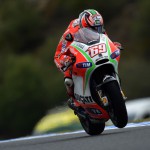Like most sports motocross is littered with tales of comeback and frequent chuckles in the face of adversity. The nature of the MX beast dictates that even the most skilled and prolific of champions will, at some point, need a grave face-to-face session with a doctor. Many make it back from a bleak diagnosis, many don’t. Some get the wheels turning…but not at the same frantic rate as perhaps a career peak that might have lasted weeks, months or years.
In 2016 Jake Nicholls has reached the top of the British Championship podium and re-established some Grand Prix credentials after a period of eighteen months and three injuries that left the 26 year old at a professional and personal low; a threshold where the towel was poised to be chucked. The fact that ‘45’ has climbed back to recognition and defied a mangled finger, sore broken arm and painful lower back – not to mention all the anguish of losing status, a saddle, a reasonable contract and a wealth of confidence – means he is already one of the splendid narratives of British off-road motorcycle sport this year. Nicholls may come from a very supportive and well-resourced family but this personal struggle – to paraphrase the late, great American writer Norman Mailer – has been like ‘sprinting up a hill of pillows’.
Rejuvenation and renaissance is not limited solely to athletes. When it comes to the Nicholls saga then there is Hitachi Construction Husqvarna; British Champions the last two years and the UK’s top team in MXGP. Roger Magee’s outfit suffered a double blow with the loss of Shaun Simpson and backing from KTM at the end of 2015. Ailing like a wounded beast with fractures right through the infrastructure of the squad (Magee also dealing with family bereavement) the team and Nicholls found the other just when each party needed a little something: Magee required both a prominent British name and revalidation for continuing the racing effort through the upheaval of switching brands and Nicholls came across a sympathetic figure in his former team (three years in MX2 before switching to Jacky Martens’ set-up for his best years in GP in 2012 and 2013) as well as one of the few avenues that did not prioritise mining the Nicholls family funds in order for Jake to rediscover if he still had what it took.
“Jake wasn’t a risk,” asserts Magee, speaking at the recent British Grand Prix. “Jake left us on very good terms and he was a lot younger then and just coming into MX2. We had seen the potential and with Jacky Martens he was able to get on the podium. We know his work ethic is very strong and we don’t have to tell him what to do because he knows what he wants. He lost his way a wee bit in the last years by trying to come back too early from a couple of bad injuries. Like with some other riders we’ve picked up in the past – where people think they are on the scrapheap – we can still see their potential and desire. We took the chance and it has worked out.”
Nicholls wasn’t on his own while wading through insecurity, anaesthesia and depressingly slow initial lap-times while trying to see if the bars would still go where he wanted. “He has definitely gone through the worst I have seen and he is slowly coming back up,” confides wife Blu. “He got to such a low point with the injuries that he was debating whether to quit. I always said I’d support him with everything…but I did not want him to quit because I didn’t feel it was his time to do that. A few people said “maybe you should…” but I knew deep down he didn’t want to. So I backed him 110% so he’d carry on, and as hard as it was we’d do it. Thankfully he did and is slowly getting better.”
Spiral fractures, breakages and concussions are just some of Nicholls’ heavy costs for a career in motocross that reached Grand Prix while he was still a teenager. “I’d grown up with injuries and just when I’d turned Pro I started a really good run and pretty much forgot about it [the rigmarole] and lost my name for being the ‘injury boy’,” he says. Nicholls blossomed in MX2 and reached the top five on Magee’s privateer bike when the class was far busier with competition boasting podium-and-winning experience (there are only two riders in the 2016 MX2 crop who have owned a Grand Prix). On the Martens KTM he lived on the periphery of the rostrum, tasted champagne at Matterley, finished fourth in the world and then arrived to the age of 23 and a forced move into the MXGP class for 2014.
That’s when things started to fall away. Nicholls showed signs of quick adaption on Steve Turner’s Forkrent KTM 450 until the fifth round of the British Championship at Whitby in July where an accident led to a badly crushed little finger on his right hand that ended his season and gave concern that he might lose the digit altogether. “I had a good four-five years of no stress at all,” he recollects. “The finger was a freak thing and I was ‘down’ about that because I was confident in my racing at the time and had come from a strong MX2 period. I had not set the world alight on a 450 but I was coming strong. I was gutted but then I hadn’t been injured for a while and thought ‘OK, I have to go through this’. It wasn’t a bad [injury] but a complicated one.”
With Steven Frossard as a high-profile (but ill-fated) teammate for 2015 Nicholls regrouped and attacked his training with verve, only to suffer a snapped arm at the first meeting of the year at LaCapelle Marival in France. The video of the crash still makes for unpleasant viewing. “I made a bad decision to ride a 350 for 2015 and didn’t get much confidence on that,” he reflects. “I didn’t look into it properly and just assumed I’d be OK when I started racing. I broke my arm in the very first race and I though ‘whoah’…it went from being bad to really bad. The whole thing went on for ages and I was really down because it didn’t feel like it was getting better. I felt like everything was slipping away: my form had totally gone, my confidence had gone completely as well. I was a different person because of that. Very unmotivated and there were times when aside from doing the work I had to do around the bike, training or rehab I didn’t want to do anything else. We were in the middle of buying a house and I just switched off from that. It changed me.”
“When I came back from the wrist I rode at the Swedish GP that summer and had a fifteenth, which was alright and I thought ‘I can chip away from here’ but then at the next round in Latvia I had a crash that wasn’t bad but it resulted in the back injury,” he continues. “To be honest from all the injuries I’ve had that is the one that has really stayed with me and always will. It is a stress fracture. The way it was explained to me is that your back is like a brain and once something happens then it ‘remembers’. I had slightly worsened a stress fracture I’d suffered when I was nine – it is quite impressive how they can tell that from a CT scan – and again it took ages; another two-three months before I could ride properly.”
It was another spell of uncertainty and frustration for Nicholls who was on the verge of losing his ride and all the good work of the Martens MX2 years. Racing stands still for nobody. “I had pretty much given up on it all by then,” he admits. “I just tried to stay fit. I came back in the British Championship at the end of 2015 and I was struggling to get in the top seven and I felt like I was trying harder than ever. I was pretty depressed about that. I was trying so hard and had given myself a month of good, hard preparation and still I was way-off some guys I had been beating by forty seconds the previous season. I then had a massive crash in the last moto of that event – the last of the year – and it just summed up that eighteen month period.”
To read the rest of the article in the new OTOR then simply click HERE
Photo by Ray Archer








